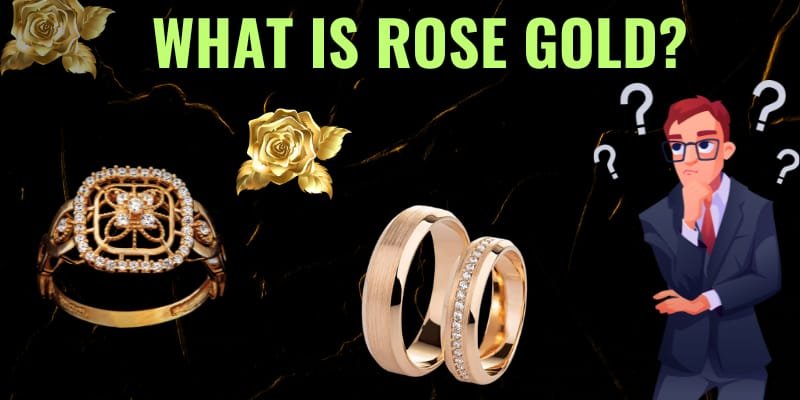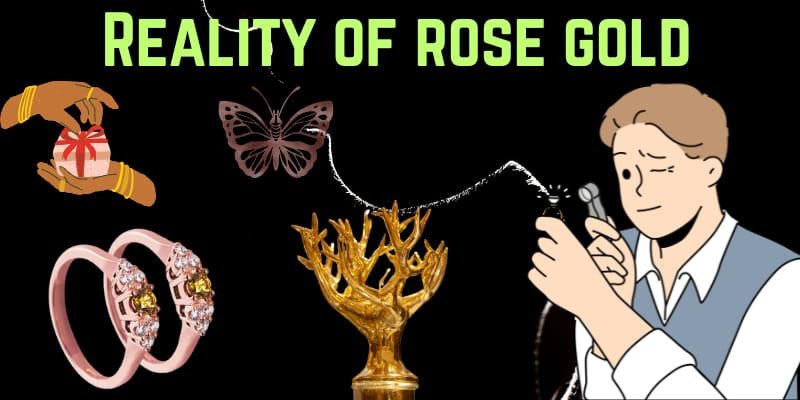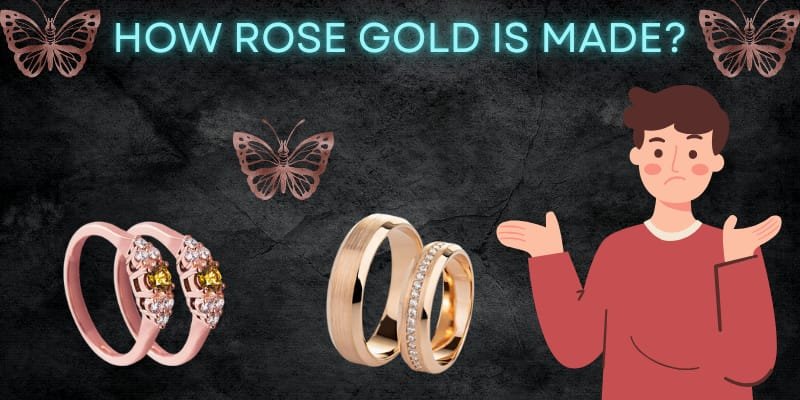What Is Rose Gold? Top 4 Types of Rose Gold. You Know?
Published: 15 Jan 2025
Hey guys!
You came here so I am sure you want to know about rose gold right? Before we go ahead, look at the picture of rose gold above, I hope you have seen it at least once.
In simple words, rose gold is a type of gold that is made by mixing pure gold with at least one white metal such as copper and even silver.
Pure gold has a deep yellow color, right? but when it’s mixed with copper or silver, it changes and becomes rosy pinkish and that’s the reason why the final product is called rose gold.
Guys, do you know the process of how rose gold is made? Are there any types of rose gold? No? Let’s Explore them. Here I shared an in-depth overview of what is white gold, how it’s made, types of rose gold, and whether it’s real or fake.
I shared every point based on my 10+ years of experience in Goldsmithing. So are you ready to learn more?
What Is Rose Gold? It’s Key Properties.

Guys, as I shared before, rose gold is an alloy, which means it’s made by mixing pure gold with copper and sometimes a touch of silver.
The copper is what gives rose gold its unique pinkish or reddish hue. Depending on the amount of copper used, the color of rose gold can vary—from a soft, delicate pink to a deeper, more intense red.
Guys you know, the durability and color of rose gold is the only reason why it suits a variety of personal styles and preferences.
Here are the key properties of rose gold that make it the best but unique from other types of gold.
Durability and Strength
Rose gold is more durable than pure gold due to the strength of copper.
- As we know, pure gold is soft and delicate, so it cannot be used for daily
- But when copper is mixed with pure gold, it becomes harder and the best choice for daily worn jewelry like engagement rings and bracelets.
Tarnish Resistance
- Rose gold doesn’t tarnish like some other metals.
- But over time, the copper content may develop a slight patina, which most people don’t care about.
- If you think it’s not good for you, you still have a solution: “Just re-polish it” and your rose gold will shine again.
Hypoallergenic Properties.
- Rose Gold is usually hypoallergenic, meaning it doesn’t cause any allergic reactions in most people.
- But people allergic to copper should avoid it as it contains copper as an active part.
Unique Aesthetic.
- Rose gold has a warm, rosy glow which makes it unique from traditional yellow and white gold.
- Due to its romantic tone, it mostly suits all skin tones from cooler to warm as well as neutral.
Are There Any Types of Rose Gold?
Yes, there are different types of rose gold depending on their color and purity level. The purity level of rose gold is determined by the letter “k” which stands for karat (sometimes also spelled as carat).
Guys, there are 4 common types of rose gold and they are,
22k Rose Gold
- Purity: Contains 91.7% pure gold and 8.3% other metals, primarily copper and a small amount of silver.
- Color: has a subtle pink hue with a richer golden undertone due to the high gold content.
18k Rose Gold
- Purity: contains 75% pure gold and 25% other metals, mainly copper and silver.
- Color: A warm, pinkish tone
14k Rose Gold
- Purity: holds 58.5% pure gold and 41.5% other metals, with a higher proportion of copper.
- Color: A more pronounced pink color due to the increased copper content.
10k Rose Gold
- Purity: consists of 41.7% pure gold and 58.3% other metals, with copper being the dominant alloy.
- Color: A deeper, reddish-pink shade because of the high copper content.
Is Rose Gold a Real Gold?

Absolutely yes, rose gold is real. Guys as we discussed above, each type of rose gold contains an appropriate percentage of pure gold so it’s considered real gold, not a fake.
Pure gold is too delicate which is not suitable for daily wear and fabrication stone settings, so metallurgists created different versions of gold to make this task easier.
The main benefits of these different versions of gold are they are affordable as well as durable also from pure gold.
How Is Rose Gold Made?

Creating rose gold is simple as we just need to mix pure gold with copper and silver by melting them. However, shaping them into desired designs requires both experience and expertise.
Here is a brief guide on how we make rose gold.
1st step
Guys, first of all, we define which type of rose gold we have to make, whether it’s 18k, 14k or 10k. After that, we determine the weight of the jewelry.
For example, if we need to make jewelry that must have 100g of weight. We will take the general weight of every metal such as
- To make 18k rose gold we will take 75% pure gold + 22.5% copper + 2.5% silver.
- For 14k rose gold: we pick up 58.3 g pure gold + 39g copper and 2.7g silver.
- And for 10k: we usually grab 41.7g pure gold + 51g copper and 7.3g of silver.
These percentages or grams of every metal can vary depending on which color and properties of rose gold we need.
However, sometimes we even make a 10k rose gold ring by mixing 6.25g pure gold with 8.45g copper and 3g of silver.
Step 2
We melt all the metals together in the crucible at a high temperature typically over 1,000°C (1,832°F). This melts the metals into a liquid state, making it easier for us to reshape gold easily.
Step 3
- Once the metals are fully combined, we pour the molten rose gold alloy into molds to give it shape.
- As the melted gold cools, the mixture solidifies into bars, sheets, or other forms, depending what we need.
Step 4: Shaping the Jewelry
The rose gold alloy is then shaped into jewelry pieces using techniques such as:
- Rolling and Cutting: For creating sheets and wires for intricate designs.
- Casting: Pouring molten rose gold into detailed molds for unique patterns.
- Handcrafting: Skilled artisans use tools to create custom designs.
Step 5: Polishing and Finishing
- After shaping, the jewelry undergoes a series of polishing steps to enhance the shine and highlight the warm blush tone.
- Some pieces may also receive special finishes, like a matte or brushed texture, to add character.
Last Step: Final Inspection
- In the last step, we inspect each piece to ensure it meets our high standards for color, strength, and craftsmanship.
- Any imperfections are refined to create flawless jewelry.
Uses of Rose Gold.

Rose gold has become popular in recent years. It’s not only used in jewelry but also becomes the best material in technology. Here is how and where rose gold is used.
- Jewelry: Used for rings, necklaces, bracelets, and earrings.
- Watches: rose gold is plated on watch cases and bands for a luxurious finish.
- Smartphones: Used for plating mobile phones for a stylish look.
- Eyewear: Found in frames for glasses and sunglasses.
- Medical Devices: Used in surgical tools such as bandage scissors and stethoscopes.
- Cosmetics: common in packaging for high-end beauty products.
- Electrical Components: Found in connectors and circuit boards due to its conductivity.
- Home Décor: Used in light fixtures, mirrors, and furniture accents.
Advantages of Rose Gold
Rose gold is a unique and stylish metal that combines beauty with practicality. Its warm, pinkish hue and durability make it a popular choice for many applications because
- It offers a romantic, timeless look that complements all skin tones.
- It’s more resistant to scratches and tarnishing than pure gold.
- Pairs well with other metals and gemstones for various designs.
- Less likely to cause allergic reactions due to its alloy composition.
- Contains a significant amount of gold, making it a valuable option in jewelry.
Disadvantages of Rose Gold
Guys, nothing is perfect in this world. Everything that has a physical presence has its own pros and cons and the same also goes for rose gold.
Despite its popularity, rose gold has some downsides that may not suit every need. For example
- Its pinkish hue can dull over time if not properly maintained.
- The alloyed metals reduce its purity and can affect resale value.
- The copper content can develop a greenish tint when exposed to moisture.
- Some individuals who are allergic to copper can also be allergic to rose gold as it contains copper as a primary part.
Interesting Facts About Rose Gold.
- Rose gold was first popularized in Russia during the 19th century with the name “Russian gold.”
- The pink hue comes primarily from copper, which gives the alloy its warm, reddish tone.
- Rose gold is not a pure metal but an alloy made by combining gold with copper and sometimes silver.
- The color of rose gold depends on copper. The more copper added, the deeper the red color of the rose gold.
- It has become a popular choice for wedding rings, especially in recent years, due to its romantic appearance.
- Rose gold doesn’t tarnish easily and can maintain its luster for a long time.
- If your rose gold seems a little bit dark, don’t worry just polish it, it will shine again.
Hey My Champs.
It’s time to say goodbye. In this article, we’ve covered what rose gold is in detail.
From understanding its key properties and how it’s made, to exploring its different types and uses, rose gold proves itself to be both practical and stylish.
You can choose rose gold for your next piece of jewelry. Its unique warmth and durability make it a perfect choice for daily wear, engagement rings, and special custom designs.
So guys, what you have finalized about rose gold? Please let me know in the comment section below, I’d love to hear from you.
Thank you & Good Luck 🤞🤞
Have More Queries?
Guys, these are some questions that people often ask related to this topic.
Rose gold is made by mixing pure gold with copper and sometimes silver. The copper gives it its unique pinkish hue. The amount of copper determines the intensity of the color.
Yes, rose gold is real gold. It contains pure gold, just mixed with other metals like copper and silver for added durability. So, it’s just a different version of gold, not fake.
Rose gold is popular because of its romantic, warm color and durability. It suits many skin tones and has a timeless appeal. It’s also a versatile metal used in both jewelry and technology.
The main types of rose gold are 22k, 18k, 14k, and 10k. These differ based on the amount of pure gold mixed with copper. Higher karat gold will have a richer, more golden tone.
Yes, rose gold is a durable metal that can be worn daily. Its copper content makes it stronger than pure gold, so it’s perfect for rings, bracelets, and other everyday jewelry. Just be mindful of tarnish and re-polish when needed.
Rose gold is resistant to tarnish, but the copper content may develop a patina. This gives it a slightly aged look, which some people find charming. If you prefer a shiny appearance, simply polish it to restore its luster.
Rose gold is generally hypoallergenic for most people. However, if you have an allergy to copper, you may want to avoid it. The copper content is what gives rose gold its color and strength.
To care for rose gold, keep it clean and dry, avoiding contact with harsh chemicals. Clean it with a soft cloth and, if needed, use a jewelry cleaning solution. Regular polishing can maintain its shine.
Yes, rose gold can be resized, just like other types of gold. However, the process requires skilled jewelers to ensure the piece maintains its integrity and design. Always seek an experienced goldsmith for resizing.
Rose gold is usually less expensive than yellow or white gold because it contains a higher percentage of copper. However, the price depends on the karat and overall design. For high-end pieces, it may cost similarly to other gold varieties.

- Be Respectful
- Stay Relevant
- Stay Positive
- True Feedback
- Encourage Discussion
- Avoid Spamming
- No Fake News
- Don't Copy-Paste
- No Personal Attacks



- Be Respectful
- Stay Relevant
- Stay Positive
- True Feedback
- Encourage Discussion
- Avoid Spamming
- No Fake News
- Don't Copy-Paste
- No Personal Attacks





